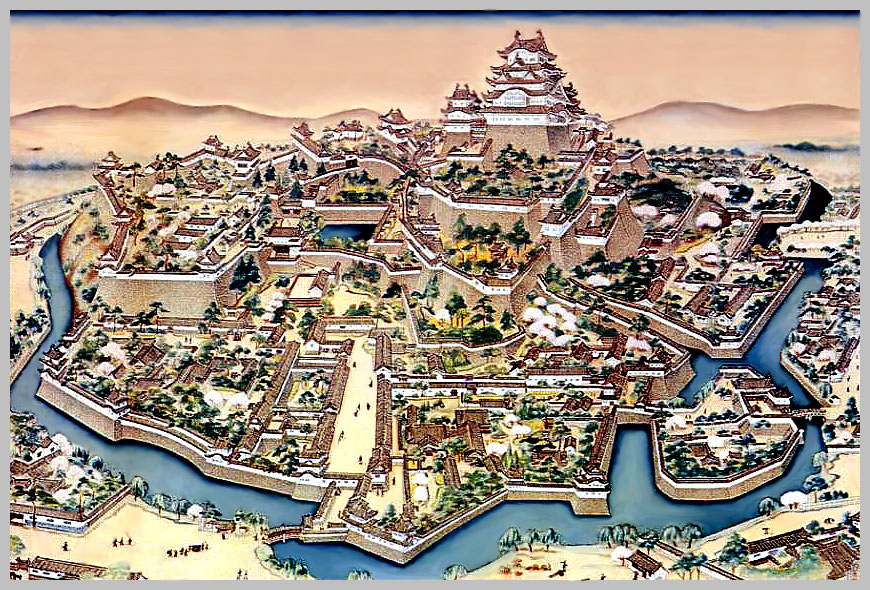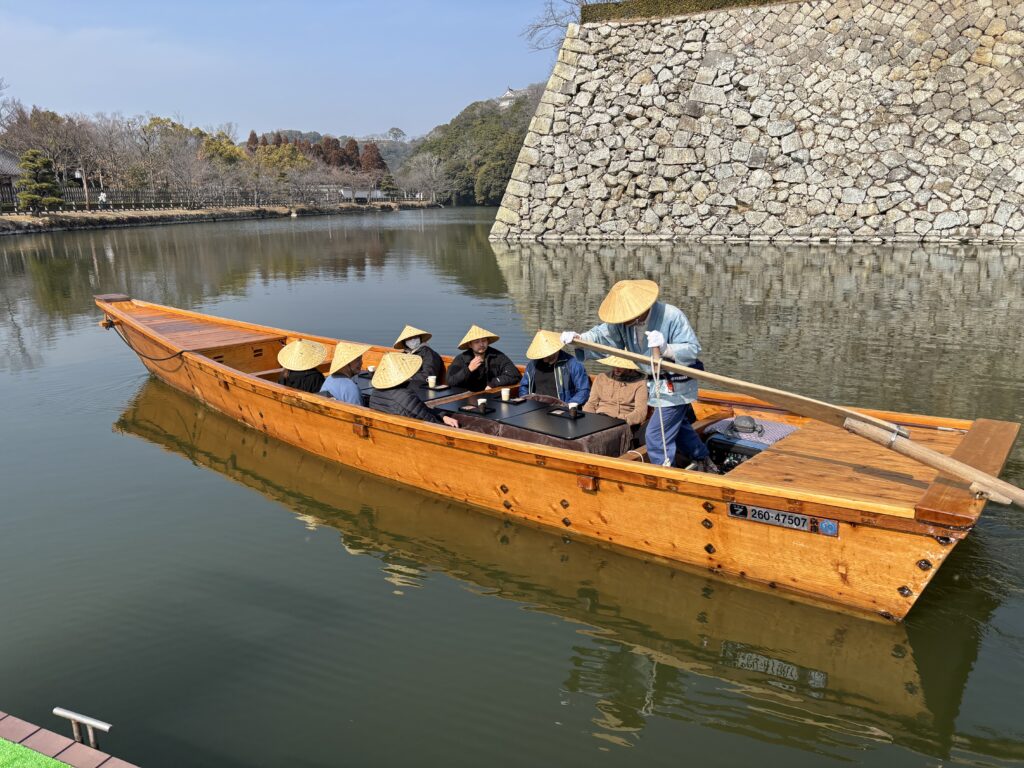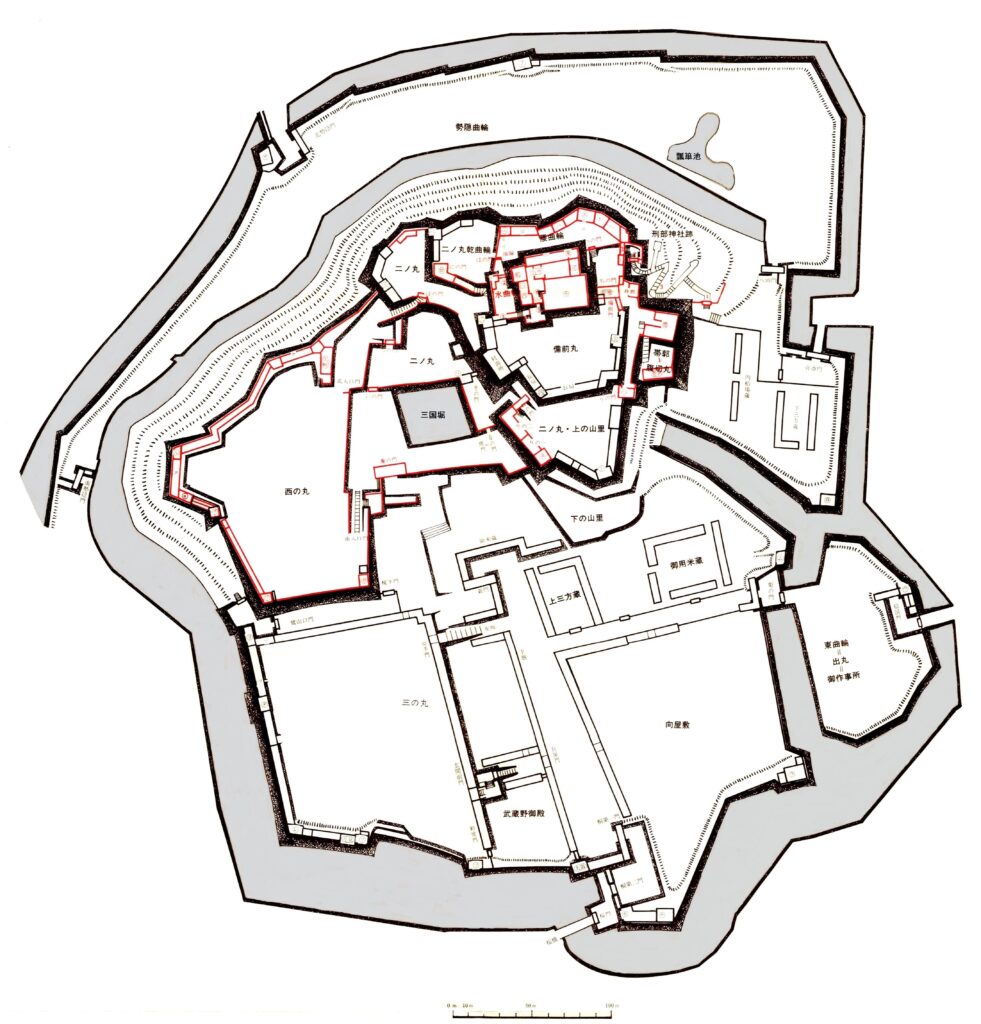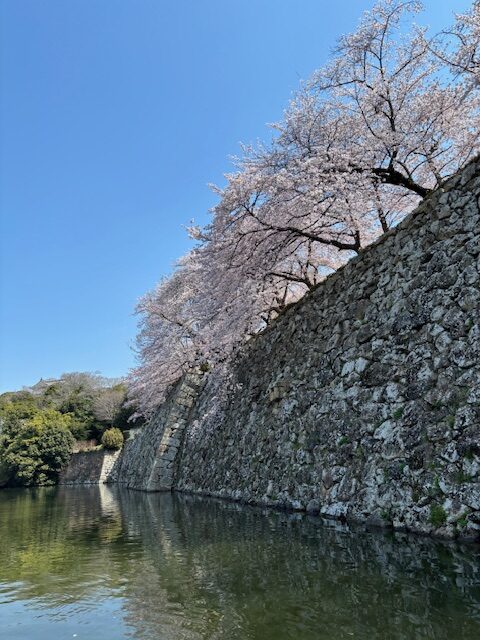Enjoy traveling back in time visiting UNESCO World Heritage and National Treasure HIMEJI CASTLE on this special Wasen Uchibori Moat Boat Tour.
Thank You!”
HIMEJI CASTLE UCHIBORI WASEN MOAT BOAT TOUR
TOUR STAGES

1.
Welcome aboard this traditional “Wasen Uchobori” handmade boat in Himeji with government subsidies. Pleasure boats are not licensed by the Agency for Cultural Affairs, but this historical “wasen” style boat from Edo era (1603-1867) was so permitted to receive funding from the Agency of Cultural Affairs. It is conditional that such an “uchibori” (moat boat) be powered by rowing while touring castles.

2.
This Himeji Castle moat is spiral shaped, so we cannot make one lap around it. Only two Japanese castles have such spiral-moats, Edo Imperial Castle in Tokyo and Himeji Castle. Himeji Castle is the largest and most visited castle in Japan. National Treasure HIMEJI CASTLE was registered in 1993 as one of the first UNESCO World Heritage Sites in Japan.

3.
Look at the high stone wall on your right, a Castle Lord lived up there. Many splendid white buildings with tiled roofs were built in that square of stone walls 400 years ago.
Unfortunately it was all destroyed by the Japanese Army when the Himeji Castle area was established as a military base in P1867 (Meiji era 1868-1912).

4.
On the right, we can see the elegant long white corridor where the famous “Princess Sen” had her private residence. The two-tiered stone wall is 7 meters below and 17 meters above the water, with the white turret rising to the highest point.
Looking at the lower stone wall, we can see there is a private entrance “loop-hole”. It is said that a boat, carrying the Castle Lord, would cross the moat to where this stone wall disappeared so he could secretly visit his concubine living above the wall.
5.
Look at the stone wall on the left. It is not an old hole, but was made by the Japanese Army during the Meiji era (1868-1912). While many repairs were made in the stone wall during the Edo era (1603-1867), the stone wall was later repaired and improved using more modern construction methods by the Japanese Army after that time. We can see where modern repairs were made in the old stone walls.
6.
A triple-turret once stood on top of this protruding stone wall. There were a total of fine triple-turrets on the south side of this moat. However, all of them were destroyed by the Japanese Army, because they needed the vacant land for a military base established in 1867. If they hadn’t destroyed the turrets we could enjoy a more splendid Himeji Castle view .
7.
Now we come to the widest part of the moat where the samurai residents would come to enjoy the night reflection of the moon on the water surface. The moat was not only for defense, but also for beautiful moon-viewing during peaceful times.
8.
The Ote-mon (Main Gate) we see there was built in 1938. While Himeji Castle was abandoned and in disrepair since the end of the Edo era (1603-1867), the nearby Himeji Castle area was used as an established military base since 1867 (Meiji era1868-1912). This later resulted in Himeji City being heavily bombed in WWII.
9.
This beautiful wooden Edo era style bridge, called “Sakuramon Bridge”, we are passing under was constructed in 2007 to replace an older smaller bridge. The previous bridge was not suitable for the many visitors coming to UNESCO World Heritage HIMEJI CASTLE.
10.
You see the tower in front of you, that is Himeji Zoo amusement park. There were no zoos in Japan during the Edo era (1603~1868), but after WWII there was a rush to build zoos and amusement parks where families could enjoy leisure time. Since Himeji Castle became a UNESCO World Heritage site, plans have been underway to restore it to it`s previous beautiful Edo era appearance.

11.
As we turn, look at this stone wall on the left you will see a red-bridge with magnificent HIMEJI CASTLE rising above it. It is a very beautiful view of HIMEJI CASTLE, especially during Cherry Blossom Season when many people take photos here. Feel free to take many beautiful photos of magnificent Himeji Castle.

12.
In front of us is Gokoku Shrine which honors the spirits of fallen soldiers. Himeji Castle area was a military base since 1867 where many soldiers trained and died in wars. This shrine was dedicated in 1938 the same year as the large Himeji Castle Main Gate (Otemon) was built.
13.
The Edo era (1603~1868) was the longest peacetime period in Japan. During 260 years of peace this moat became a place of entertainment where “bushi” enjoyed boating and moon viewing events. But in 1945, 340 years after this moat was built, it protected HIMEJI CASTLE from air attacks by Allied Forces. When seeing night flares and moonlight reflecting on the water surface HIMEJI CASTLE area looked like a body of water, so incendiary bombs weren`t dropped on it.
14.
However, the story of the World War II air raids over Himeji Castle continued even 12 years after becoming a World Heritage site (1993). For the first time people knew that just after WWII an unexploded incendiary bomb was found lying on the top floor of Himeji Castle Main Keep.
A Japanese bomb disposal soldier testified 60 years later that he and his military bomb disposal companions carried the 100 pound bomb down the steep castle stairs. “It`s was a dangerous mission, if we failed we would have lost our lives and our precious castle.”, he said.
15.
For over 400 years Himeji Castle has survived periods of war and peace with this moat giving both defensive and entertainment value. We hope after many years of repairs and renovations that UNESCO World Heritage National Treasure HIMEJI CASTLE and this moat will continue to add beauty and historical charm to visitors for many years to come. For hundreds of years Himeji Citizens have been proud of Himeji Castle and are happy that it can be enjoyed by it`s many visitors.
We hope you enjoyed touring Himeji Castle moat on a traditional “wasen” Japanese boat.
Thank you for coming on board!
Please enjoy many other interesting and historical sites in Himeji City and Japan.
(Please give this Information Paper to Tour Staff after tour.)
